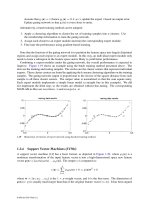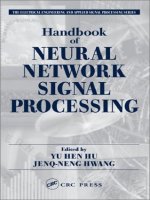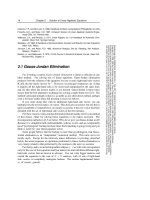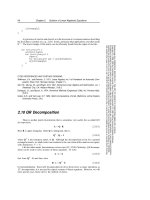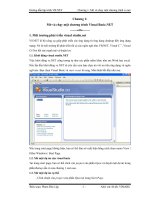Tài liệu Handbook of Neural Network Signal Processing P1 ppt
Bạn đang xem bản rút gọn của tài liệu. Xem và tải ngay bản đầy đủ của tài liệu tại đây (963.14 KB, 30 trang )
Handbook
of
NEURAL
NETWORK
SIGNAL
PROCESSING
© 2002 by CRC Press LLC
THE ELECTRICAL ENGINEERING
AND APPLIED SIGNAL PROCESSING SERIES
Edited by Alexander Poularikas
The Advanced Signal Processing Handbook:
Theory and Implementation for Radar, Sonar,
and Medical Imaging Real-Time Systems
Stergios Stergiopoulos
The Transform and Data Compression Handbook
K.R. Rao and P.C. Yip
Handbook of Multisensor Data Fusion
David Hall and James Llinas
Handbook of Neural Network Signal Processing
Yu Hen Hu and Jenq-Neng Hwang
Handbook of Antennas in Wireless Communications
Lal Chand Godara
Forthcoming Titles
Propagation Data Handbook for Wireless Communications
Robert Crane
The Digital Color Imaging Handbook
Guarav Sharma
Applications in Time Frequency Signal Processing
Antonia Papandreou-Suppappola
Noise Reduction in Speech Applications
Gillian Davis
Signal Processing in Noise
Vyacheslav Tuzlukov
Electromagnetic Radiation and the Human Body:
Effects, Diagnosis, and Therapeutic Technologies
Nikolaos Uzunoglu and Konstantina S. Nikita
Digital Signal Processing with Examples in M
ATLAB
®
Samuel Stearns
Smart Antennas
Lal Chand Godara
Pattern Recognition in Speech and Language Processing
Wu Chou and Bing Huang Juang
© 2002 by CRC Press LLC
CRC PRESS
Boca Raton London New York Washington, D.C.
Edited by
YU HEN HU
JENQ-NENG HWANG
Handbook
of
NEURAL
NETWORK
SIGNAL
PROCESSING
This book contains information obtained from authentic and highly regarded sources. Reprinted material is quoted with
permission, and sources are indicated. A wide variety of references are listed. Reasonable efforts have been made to publish
reliable data and information, but the author and the publisher cannot assume responsibility for the validity of all materials
or for the consequences of their use.
Neither this book nor any part may be reproduced or transmitted in any form or by any means, electronic or mechanical,
including photocopying, microfilming, and recording, or by any information storage or retrieval system, without prior
permission in writing from the publisher.
All rights reserved. Authorization to photocopy items for internal or personal use, or the personal or internal use of specific
clients, may be granted by CRC Press LLC, provided that $1.50 per page photocopied is paid directly to Copyright clearance
Center, 222 Rosewood Drive, Danvers, MA 01923 USA. The fee code for users of the Transactional Reporting Service is
ISBN 0-8493-2359-2/01/$0.00+$1.50. The fee is subject to change without notice. For organizations that have been granted
a photocopy license by the CCC, a separate system of payment has been arranged.
The consent of CRC Press LLC does not extend to copying for general distribution, for promotion, for creating new works,
or for resale. Specific permission must be obtained in writing from CRC Press LLC for such copying.
Direct all inquiries to CRC Press LLC, 2000 N.W. Corporate Blvd., Boca Raton, Florida 33431.
Trademark Notice:
Product or corporate names may be trademarks or registered trademarks, and are used only for
identification and explanation, without intent to infringe.
Visit the CRC Press Web site at www.crcpress.com
© 2002 by CRC Press LLC
No claim to original U.S. Government works
International Standard Book Number 0-8493-2359-2
Library of Congress Card Number 2001035674
Printed in the United States of America 1 2 3 4 5 6 7 8 9 0
Printed on acid-free paper
Library of Congress Cataloging-in-Publication Data
Handbook of neural network signal processing / editors, Yu Hen Hu, Jenq-Neng Hwang.
p. cm.— (Electrical engineering and applied signal processing (Series))
Includes bibliographical references and index.
ISBN 0-8493-2359-2
1. Neural networks (Computer science)—Handbooks, manuals, etc. 2. Signal
processing—Handbooks, manuals, etc. I. Hu, Yu Hen. II. Hwang, Jenq-Neng. III.
Electrical engineering and signal processing series.
QA76.87 H345 2001
006.3
′
2—dc21 2001035674
disclaimer Page 1 Wednesday, August 1, 2001 10:12 AM
Preface
The field of artificial neural networks has made tremendous progress in the past 20 years in terms
of theory, algorithms, and applications. Notably, the majority of real world neural network appli-
cations have involved the solution of difficult statistical signal processing problems. Compared to
conventional signal processing algorithms that are mainly based on linear models, artificial neural
networks offer an attractive alternative by providing nonlinear parametric models with universal
approximation power, as well as adaptive training algorithms. The availability of such powerful
modeling tools motivated numerous research efforts to explore new signal processing applications
of artificial neural networks. During the course of the research, many neural network paradigms were
proposed. Some of them are merely reincarnations of existing algorithms formulated in a neural
network-like setting, while the others provide new perspectives toward solving nonlinear adaptive
signal processing. More importantly, there are a number of emergent neural network paradigms that
have found successful real world applications.
The purpose of this handbook is to survey recent progress in artificial neural network theory,
algorithms (paradigms) with a special emphasis on signal processing applications. We invited a
panel of internationally well known researchers who have worked on both theory and applications of
neural networks for signal processing to write each chapter. There are a total of 12 chapters plus one
introductory chapter in this handbook. The chapters are categorized into three groups. The first group
contains in-depth surveys of recent progress in neural network computing paradigms. It contains five
chapters, including the introduction, that deal with multilayer perceptrons, radial basis functions,
kernel-based learning, and committee machines. The second part of this handbook surveys the neural
network implementations of important signal processing problems. This part contains four chapters,
dealing with a dynamic neural network for optimal signal processing, blind signal separation and
blind deconvolution, a neural network for principal component analysis, and applications of neural
networks to time series predictions. The third part of this handbook examines signal processing
applications and systems that use neural network methods. This part contains chapters dealing
with applications of artificial neural networks (ANNs) to speech processing, learning and adaptive
characterization of visual content in image retrieval systems, applications of neural networks to
biomedical image processing, and a hierarchical fuzzy neural network for pattern classification.
The theory and design of artificial neural networks have advanced significantly during the past
20 years. Much of that progress has a direct bearing on signal processing. In particular, the nonlinear
nature of neural networks, the ability of neural networks to learn from their environments in super-
vised and/or unsupervised ways, as well as the universal approximation property of neural networks
make them highly suited for solving difficult signal processing problems.
From a signal processing perspective, it is imperative to develop a proper understanding of basic
neural network structures and how they impact signal processing algorithms and applications. A
challenge in surveying the field of neural network paradigms is to distinguish those neural network
structures that have been successfully applied to solve real world problems from those that are still
under development or have difficulty scaling up to solve realistic problems. When dealing with
signal processing applications, it is critical to understand the nature of the problem formulation so
that the most appropriate neural network paradigm can be applied. In addition, it is also important
to assess the impact of neural networks on the performance, robustness, and cost-effectiveness of
signal processing systems and develop methodologies for integrating neural networks with other
signal processing algorithms.
© 2002 by CRC Press LLC
We would like to express our sincere thanks to all the authors who contributed to this hand-
book: Michael T. Manry, Hema Chandrasekaran, and Cheng-Hsiung Hsieh (Chapter 2); Andrew
D. Back (Chapter 3); Klaus-Robert Müller, Sebastian Mika, Gunnar Rätsch, Koji Tsuda, and Bern-
hard Scholköpf (Chapter 4); Volker Tresp (Chapter 5); Jose C. Principe (Chapter 6); Scott C. Douglas
(Chapter 7); Konstantinos I. Diamantaras (Chapter 8); Yuansong Liao, John Moody, and Lizhong
Wu (Chapter 9); Shigeru Katagirig (Chapter 10); Paisarn Muneesawang, Hau-San Wong, Jose Lay,
and Ling Guan (Chapter 11); Tülay Adali, Yue Wang, and Huai Li (Chapter 12); and Jinshiuh
Taur, Sun-Yuan Kung, and Shang-Hung Lin (Chapter 13). Many reviewers have carefully read the
manuscript and provided many constructive suggestions. We are most grateful for their efforts.
They are Andrew D. Back, David G. Brown, Laiwan Chan, Konstantinos I. Diamantaras, Adriana
Dumitras, Mark Girolami, Ling Guan, Kuldip Paliwal, Amanda Sharkey, and Jinshiuh Taur.
We would like to thank the editor-in-chief of this series of handbooks, Dr. Alexander D. Poularikas,
for his encouragement. Our most sincere appreciation to Nora Konopka at CRC Press for her infinite
patience and understanding throughout this project.
© 2002 by CRC Press LLC
Editors
Yu Hen Hu received a B.S.E.E. degree from National Taiwan University, Taipei, Taiwan, in 1976.
He received M.S.E.E. and Ph.D. degrees in electrical engineering from the University of Southern
California in Los Angeles, in 1980 and 1982, respectively. From 1983 to 1987, he was an assistant
professor in the electrical engineering department of Southern Methodist University in Dallas, Texas.
He joined the department of electrical and computer engineering at the University of Wisconsin in
Madison, as an assistant professor in 1987, and he is currently an associate professor. His research
interests include multimedia signal processing, artificial neural networks, fast algorithms and design
methodology for application specific micro-architectures, as well as computer aided design tools for
VLSI using artificial intelligence. He has published more than 170 technical papers in these areas.
His recent research interests have focused on image and video processing and human computer
interface.
Dr. Hu is a former associate editor for IEEE Transactions of Acoustic, Speech, and Signal Pro-
cessing in the areas of system identification and fast algorithms. He is currently associate editor of
the Journal of VLSI Signal Processing. He is a founding member of the Neural Network Signal Pro-
cessing Technical Committee of the IEEE Signal Processing Society and served as committee chair
from 1993 to 1996. He is a former member of the VLSI Signal Processing Technical Committee of
the Signal Processing Society. Recently, he served as the secretary of the IEEE Signal Processing
Society (1996–1998).
Dr. Hu is a fellow of the IEEE.
Jenq-Neng Hwang holds B.S. and M.S. degrees in electrical engineering from the National Taiwan
University, Taipei, Taiwan. After completing two years of obligatory military services after college,
he enrolled as a research assistant at the Signal and Image Processing Institute of the department of
electrical engineering at the University of Southern California, where he received his Ph.D. degree
in December 1988. He was also a visiting student at Princeton University from 1987 to 1989.
In the summer of 1989, Dr. Hwang joined the Department of Electrical Engineering of the Uni-
versity of Washington in Seattle, where he is currently a professor. He has published more than
150 journal and conference papers and book chapters in the areas of image/video signal processing,
computational neural networks, and multimedia system integration and networking. He received the
1995 IEEE Signal Processing Society’s Annual Best Paper Award (with Shyh-Rong Lay and Alan
Lippman) in the area of neural networks for signal processing.
Dr. Hwang is a fellow of the IEEE. He served as the secretary of the Neural Systems and Applica-
tions Committee of the IEEE Circuits and Systems Society from 1989 to 1991, and he was a member
of the Design and Implementation of Signal Processing Systems Technical Committee of the IEEE
Signal Processing Society. He is also a founding member of the Multimedia Signal Processing Tech-
nical Committee of the IEEE Signal Processing Society. He served as the chairman of the Neural
Networks Signal Processing Technical Committee of the IEEE Signal Processing Society from 1996
to 1998, and he is currently the Society’s representative to the IEEE Neural Network Council. He
served as an associate editor for IEEE Transactions on Signal Processing from 1992 to 1994 and
currently is the associate editor for IEEE Transactions on Neural Networks and IEEE Transactions
on Circuits and Systems for Video Technology. He is also on the editorial board of the Journal of
VLSI Signal Processing Systems for Signal, Image, and Video Technology. Dr. Hwang was the con-
ference program chair of the 1994 IEEE Workshop on Neural Networks for Signal Processing held in
Ermioni, Greece in September 1994. He was the general co-chair of the International Symposium on
© 2002 by CRC Press LLC
Artificial Neural Networks held in Hsinchu, Taiwan in December 1995. He also chaired the tutorial
committee for the IEEE International Conference on Neural Networks held in Washington, D.C. in
June 1996. He was the program co-chair of the International Conference on Acoustics, Speech, and
Signal Processing in Seattle, Washington in 1998.
© 2002 by CRC Press LLC
Contributors
Tülay Adali
University of Maryland
Baltimore, Maryland
Andrew D. Back
Windale Technologies
Brisbane, Australia
Hema Chandrasekaran
U.S. Wireless Corporation
San Ramon, California
Konstantinos I.
Diamantaras
Technological Education Institute
of Thessaloniki
Sindos, Greece
Scott C. Douglas
Southern Methodist University
Dallas, Texas
Ling Guan
University of Sydney
Sydney, Australia
Cheng-Hsiung Hsieh
Chien Kou Institute of Technology
Changwa
Taiwan, China
Yu Hen Hu
University of Wisconsin
Madison, Wisconsin
Jenq-Neug Hwang
University of Washington
Seattle, Washington
Shigeru Katagiri
Intelligent Communication Science
Laboratories
Kyoto, Japan
Sun-Yuan Kung
Princeton University
Princeton, New Jersey
Jose Lay
University of Sydney
Sydney, Australia
Huai Li
University of Maryland
Baltimore, Maryland
Yuansong Liao
Oregon Graduate Institute of
Science and Technology
Beaverton, Oregon
Shang-Hung Lin
EPSON Palo Alto Laboratories
ERD
Palo Alto, California
Michael T. Manry
University of Texas
Arlington, Texas
Sebastian Mika
GMD FIRST
Berlin, Germany
John Moody
Oregon Graduate Institute of
Science and Technology
Beaverton, Oregon
Klaus-Robert Müler
GMD FIRST and University of
Potsdam
Berlin, Germany
Paisarn Muneesawang
University of Sydney
Sydney, Australia
Jose C. Principe
University of Florida
Gainesville, Florida
Gunnar Rätsch
GMD FIRST and University of
Potsdam
Berlin, Germany
Bernhard Schölkopf
Max-Planck-Institut für
Biologische Kybernetik
Tübingen, Germany
Junshiuh Taur
National Chung-Hsing University
Taichung
Taiwan, China
Volker Tresp
Siemens AG
Corporate Technology
Munich, Germany
Koji Tsuda
AIST Computational Biology
Research Center
Tokyo, Japan
Yue Wang
The Catholic Universtiy of
America
Washington, DC
Hau-San Wong
University of Sydney
Sydney, Australia
Lizhong Wu
HNC Software, Inc.
San Diego, California
2359/Contributors Page i Thursday, August 2, 2001 12:52 PM
© 2002 by CRC Press LLC
Contents
1
IntroductiontoNeuralNetworksforSignalProcessingYuHenHuandJenq-
NengHwang
2
SignalProcessingUsingtheMultilayerPerceptronMichaelT.Manry,Hema
Chandrasekaran,andCheng-HsiungHsieh
3
RadialBasisFunctionsAndrewD.Back
4
AnIntroductiontoKernel-BasedLearningAlgorithmsKlaus-RobertMüller,
SebastianMika,GunnarRätsch,KojiTsuda,andBernhardSchölkopf
5
CommitteeMachinesVolkerTresp
6
DynamicNeuralNetworksandOptimalSignalProcessingJoseC.Principe
7
BlindSignalSeparationandBlindDeconvolutionScottC.Douglas
8
NeuralNetworksandPrincipalComponentAnalysisKonstantinosI.
Diamantaras
9
ApplicationsofArtificialNeuralNetworkstoTimeSeriesPredictionYuansong
Liao,JohnMoody,andLizhongWu
10
ApplicationsofArtificialNeuralNetworks(ANNs)toSpeechProcessingShigeru
Katagiri
11
LearningandAdaptiveCharacterizationofVisualContentsinImageRetrieval
SystemsPaisarnMuneesawang,Hau-SanWong,JoseLay,andLingGuan
12
ApplicationsofNeuralNetworkstoImageProcessingTülayAdali,YueWang,
andHuaiLi
13
HierarchicalFuzzyNeuralNetworksforPatternClassificationJinshiuhTaur,
Sun-YuanKung,andShang-HungLin
© 2002 by CRC Press LLC
1
Introduction to Neural Networks
for Signal Processing
Yu Hen Hu
University of Wisconsin
Jenq-Neng Hwang
University of Washington
1.1Introduction
1.2ArtificialNeuralNetwork(ANN)Models—An
Overview
Basic Neural Network Components
•
Multilayer Perceptron
(MLP) Model
•
Radial Basis Networks
•
Competitive Learning
Networks
•
Committee Machines
•
Support Vector Machines
(SVMs)
1.3NeuralNetworkSolutionstoSignalProcessing
Problems
Digital Signal Processing
1.4OverviewoftheHandbook
References
1.1 Introduction
The theory and design of artificial neural networks have advanced significantly during the past
20 years. Much of that progress has a direct bearing on signal processing. In particular, the non-
linear nature of neural networks, the ability of neural networks to learn from their environments in
supervised as well as unsupervised ways, as well as the universal approximation property of neural
networks make them highly suited for solving difficult signal processing problems.
From a signal processing perspective, it is imperative to develop a proper understanding of basic
neural network structures and how they impact signal processing algorithms and applications. A
challenge in surveying the field of neural network paradigms is to identify those neural network
structures that have been successfully applied to solve real world problems from those that are still
under development or have difficulty scaling up to solve realistic problems. When dealing with
signal processing applications, it is critical to understand the nature of the problem formulation so
that the most appropriate neural network paradigm can be applied. In addition, it is also important
to assess the impact of neural networks on the performance, robustness, and cost-effectiveness of
signal processing systems and develop methodologies for integrating neural networks with other
signal processing algorithms. Another important issue is how to evaluate neural network paradigms,
learning algorithms, and neural network structures and identify those that do and do not work reliably
for solving signal processing problems.
This chapter provides an overview of the topic of this handbook — neural networks for signal
processing. The chapter first discusses the definition of a neural network for signal processing
and why it is important. It then surveys several modern neural network models that have found
successful signal processing applications. Examples are cited relating to how to apply these nonlinear
© 2002 by CRC Press LLC



